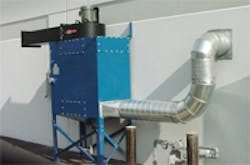Mist Collector Installation: Part 1
The capabilities of a mist collector itself are key factors in choosing the system that is right for a shop’s needs. However, there are several installation considerations that also can influence the choice of a mist collector. These include the intended location of the collector, capture hood options, and pick-up point location.
Although mist collectors are installed indoors, from time to time questions arise about locating them outdoors. For those installations, keep in mind these points:
The first concern is whether or not the intended location is an area where tempratures may fall below 32 degrees F., either occasionally or frequently, either during the day or at night. If such temperatures occur, water in water-soluble coolants will freeze.
Although the air temperature exhausted through the mist collector may be warmer, drain lines typically operate at ambient temperatures and may freeze. Also, consider times when the system is off. Ice in a mist collector will prevent proper draining and may blind-off filters.
When collecting straight oil or other non-water-soluble liquids, fluid viscosity is a factor. While oil does not freeze at 32 degrees F., it does thicken as the weather gets colder, and draining could be inhibited, both from the filters and through the drain.
When collecting water-soluble coolants, exhausting water vapor or humid air into colder outdoor air can cause water vapor to condense, so that a water cloud develops. This will look like the filtration system is not working, and if the intended facility is located in or near a residential area, people driving by may log a complaint about the visible emissions. This could then trigger a visit (and possibly an investigation) by the local or state environmental agency.
Close attention should be given to an outdoor mist collector’s gasketed seams, electrical connections, pressure taps, and the like, to ensure that rain and other weather conditions do not negatively affect the unit’s performance. A roof and/or partial enclosure around the mist collector is recommended to minimize weatherrelated failures to the mist collector. If this isn’t possible, a weather cover on the exhaust of the unit should be installed. This will turn the vertical exhaust of a mist collector downward to minimize the chance of windblown rain and weather from affecting the internals of the unit.
Hooding designs
Although mist collectors are mounted directly or ducted to a machine tool enclosure, about 10 percent of mist applications require special hood designs. These applications include machines that are over 20 years old; custom machine tools that handle extremely large parts and cannot be well enclosed; machines where top access is critical for loading parts and tools; and situations that now require air filtration due to indoor air quality regulations on applications other than metal cutting and forming.
Probably one of the best resources to consult when designing custom hoods is Industrial Ventilation – A Manual of Recommended Practice by the American Conference of Governmental Industrial Hygienists Inc. It includes dozens of hood designs and recommended airflow calculations, depending on the size of the hood.
To determine proper hood size, which is not always clear, a shop should consider how the mist is being generated. Is mist rising due to a hot process? Is mist thrown in one general direction from a machine tool or coolant spray nozzle? Is it being scattered in every direction?
The key is to look directly at the generation source and track what the mist does, rather than looking at the mist above or near the process. In most cases, the majority of mist travels in one direction, making it easy to capture, and the capture hood should be as large as it needs to be to capture the mist generated at the source. Also, it should be located as near as possible to the generation source.
After sizing a hood, shops need to calculate how much airflow is needed to capture mist (see table below). To determine the amount of airflow required for the hood, apply the equation Q=V (10 X2 +A), where Q equals the required airflow in cubic feet per minute, V is capture velocity in feet per minute, X is the distance from the source in feet, and A equals the face area of the hood in square feet.
The closer the hood is to the source of mist and the smaller the hood, the lower will be the amount of airflow required to remove the mist, and the smaller will be the mist collector.
Information supplied by Donaldson Company. Look for Parts II and III in the next two issues.
| Recommended capture velocities for mist collection hoods from the Industrial Ventilation – A Manual of Recommended Practice | ||
| Released at or into | Application examples | Capture velocity (ft/min |
| Low velocity/moderately still air | Batch part washers, die casting, thermal rise applications | 100 – 200 |
| Active generation | Low speed lathes, cold headers, stamping | 200 – 500 |
| High initial velocity | Most metal cutting, grinding | 500 – 2,000 |
